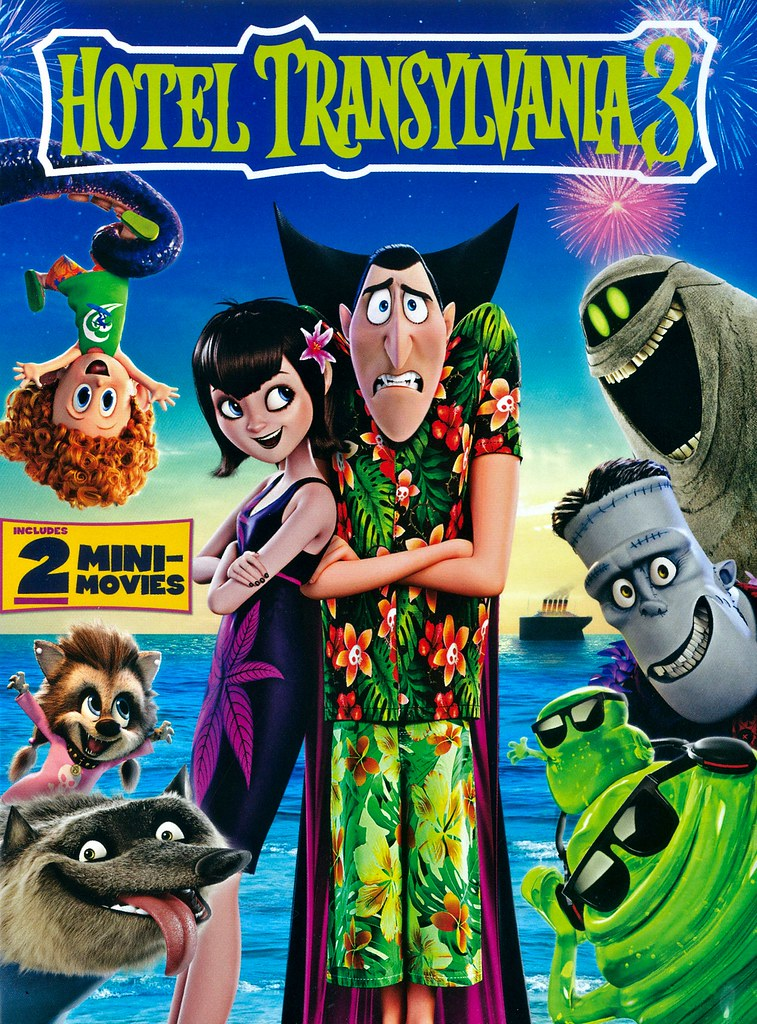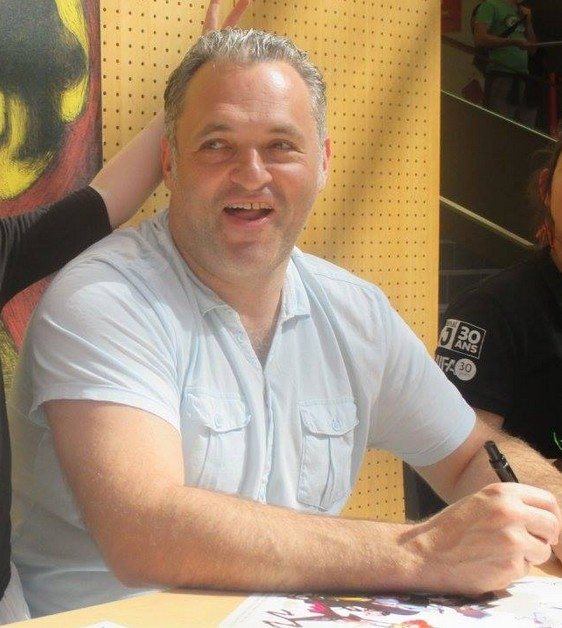Title of the work
Studio / Production Company
Country of the First Edition
Country/countries of popularity
Original Language
First Edition Date
First Edition Details
Hotel Transylvania 3: Summer Vacation. Directed by Genndy Tartakovsky. Screenplay by Genndy Tartakovsky and Michael McCullers. USA: Sony Pictures Animation, 2018, 97 min.
Running time
Date of the First DVD or VHS
Awards
2019 – Kids' Choice Awards:
Favourite Male Voice from an Animated Movie for Adam Sandler,
Favorite Female Voice from an Animated Movie for Selena Gomez.
Genre
Animated films
Target Audience
Crossover
Cover

Retrieved from flickr.com, uploaded by School Library. Licensed under CC BY-NC-ND 2.0 (accessed: January 10, 2022).
Author of the Entry:
Agnieszka Maciejewska, University of Warsaw, agnieszka.maciejewska@student.uw.edu.pl
Peer-reviewer of the Entry:
Elżbieta Olechowska, University of Warsaw, elzbieta.olechowska@gmail.com
Daniel A. Nkemleke, University of Yaounde 1, nkemlekedan@yahoo.com

Michael McCullers
, b. 1971
(Director, Screenwriter)
Michael McCullers was born in Alabama. He studied at Indian Springs School. He is a well – known screen writer and director who created many live-action movies and animations.He directed: Baby Mama (2008) and is the author of screen scripts for the Thunderbirds (2004), Boss Baby (2017) and Hotel Transylvania 3 (2018).
Sources:
trendcelebsnow.com (accessed: April 29, 2020);
bccymca.org (accessed: April 29, 2020);
imdb.com (accessed: April 29, 2020).
Bio prepared by Agnieszka Maciejewska, University of Warsaw, agnieszka.maciejewska@student.uw.edu.pl

Genndy Tartakovsky by Boungawa, 2015. Retrieved from Wikimedia Commons, licensed under CC BY-SA 4.0 (accessed: January 10, 2022).
Genndy Tartakovsky
, b. 1970
(Author, Scriptwriter)
Tartakovsky, an author and script writer, was born in Russia in an assimilated Jewish family. When he was seven years old he moved with his family to the U.S. At the age of 16, he had to combine work with high school because of his father’s death. Later he studied at the Columbia College and at Chicago and California Institute of the Arts. In these schools, he took his first steps in animation. His new skills allowed him to create such cartoons as Dexter’s Laboratory, Star Wars: Clone Wars and Hotel Transylvania which was his movie debut in 2012.
Sources:
notablebiographies.com (accessed: April 22, 2020);
imdb.com (accessed: April 22, 2020);
cartoonnetwork.fandom.com (accessed: April 22, 2020);
Interview with Genndy Tartakovsky (accessed: April 22, 2020).
Bio prepared by Agnieszka Maciejewska, University of Warsaw, agnieszka.maciejewska@student.uw.edu.pl
Casting
Adam Sandler as Dracula,
Andy Samberg as Johnny,
Selena Gomez as Mavis,
Kevin James as Frank,
David Spade as Griffin,
Steve Buscemi as Wayne,
Keegan-Michael Key as Murray,
Molly Shannon as Wanda,
Fran Drescher as Eunice,
Kathryn Hahn as Ericka,
Jim Gaffigan as Professor Abraham Van Helsing,
Mel Brooks as Vlad.
Sequels, Prequels and Spin-offs
Prequels:
Hotel Transylvania 3: Summer Vacation is the third part of Hotel Transylvania.
The remaining parts:
Hotel Transylvania 2 (World premiere 25 September 2015)
Hotel Transylvania (World premiere 28 September 2012)
Sequel:
The opening night of the fourth part of the series is planned for December 22, 2021 (imdb.com, accessed: March 17, 2020).
Summary
Hotel Transylvania series focuses on the adventures of Dracula and his loved ones. They live in the Hotel built to protect monsters from people. Action of the third part of the series begins in 1897. The protagonists – Dracula, Murray, Frank and Wayne travel by train to Budapest. They meet the famous monster’s hunter Van Helsing. He continues his family’s tradition with a true devotion; his biggest dream is to defeat Dracula. In the end, he is defeated by him. Then the action moves to the present times to Dracula’s hotel. He is overwhelmed by the hotel’s duties. His daughter Mavis decides to organize holiday trip for her friends and family. They travel on a plane to the Bermuda Triangle and then switch to a cruise ship to start a wonderful voyage with the final destination – Atlantis. Van Helsing’s granddaughter Erica is the ship’s captain. Dracula falls in love with her and tries to win over her heart. The hidden purpose of the cruise is to destroy all the monsters. They are supposed to be killed by Kraken, the guardian of Atlantis. Initially, Erica takes advantage of Dracula’s feelings but in the end, she falls for him too. In the final scenes, love and music create a happy ending for everyone. People and monsters start to live in peace and harmony.
Analysis
There are many pop culture and Antiquity references in this animation.
In each part of the animation, there is an interesting representation of Hydra. It is not a scary monster described by Hesiod in Theogony. Hydra has a powerful body with many heads but after having a closer look we realize that the heads are not scary, they are dogs’ heads and the body is covered with fur. This appearance makes Hydra looks more friendly for the young spectators but at the same time, it shows how the ancients imagined this monster (one body, many heads). The monster’s fur in the animation is blue which may refer to water and Hydra’s connection with this element in Antiquity.
In the animation, we witness a really interesting image of Atlantis – the final destination of the cruise for Dracula and his family and friends. Atlantis is shown as a recently discovered city which was the cradle of monsters’ civilization. Its greatness overshadows Rome and Athens. Initially, the city doesn’t seem at all like the one we read about in Plato’s dialogues – Timaeus and Critias. Instead of a city with districts placed in circles, we get a high mountain with a shiny neon. When our heroes enter the city, we see many mythological motifs incorporated into the city image.
The main hall is designed only for entertainment (many game slots) and it is underwater and covered by a glass ceiling. People inside the structure can observe the external underwater life with many types of fish swimming around. However, the real lost city or its ruins are situated under the main hall. As Erica enters into the hall with the intention of securing a weapon to defeat the monster, the viewers can notice ruined ionic columns and sculptures of Greek warriors. Both motifs may refer to the tragedy of the total destruction of the city by the sea. In many cultural texts, we can find the motif of Atlantis, the underwater city – e.g., in Aquaman or in the animation The Little Mermaid by Disney. The director of the Hotel Transylvania used and connected those motifs by placing the main hall under water. The color of the walls also refers to that element. The water is flowing down creating a water curtain on the walls and beautiful white columns show the way to the leisure and entertainment area of the building.
Not only the interior of the city is intriguing. The club hall which emerges from the depth of the sea is a round platform with walls created by connected columns. It brings to mind Colosseum where monsters were supposed to fight with the legendary Kraken, the guardian of Atlantis.
Initially, also the Kraken is shown as a friendly monster. He invites all the guests to join him for a party. When Erica gets the ultimate weapon (the score) and Van Helsing uses it, the Kraken changes under the influence of the music and wants to destroy all the other monsters. Kraken doesn’t look like a friendly monster anymore; he is a giant octopus with huge tentacles and sharp teeth. He is being controlled by music and depending on the genre and tone he can either be friendly or aggressive. The Kraken doesn’t resemble the ancient sea monster at all but its behavior demonstrates how important music was back then in ancient times, and that it still is timeless and important*.
The last interesting ancient motif is a person who pops up on Dracula’s Zingr (the monster version of Tinder). The spectator can see many different types of monsters but one is particularly interesting. The Cycloptimit, a young, attractive lady Cyclops with a warm smile. Dracula rejects her because she doesn’t have a full pair of eyes. This joke helps the young viewer to connect the name of the ancient monster with its characteristic feature.
All these references and motifs provide the young viewers with the possibility of learning new things through entertainment and leisure.
* Octopuses are well known for being the most intelligent sea creatures. They are sensitive to different types of music. Maybe those facts influenced creating the Kraken as an octopus controlled by music. An example of the experiment on octopuses and the influence music has on them may be watched here (accessed: March 18, 2020).
Further Reading
Tracey Miller-Zarneke, The Art and Making of ‘Hotel Transylvania’, Titan Books, 2012.


